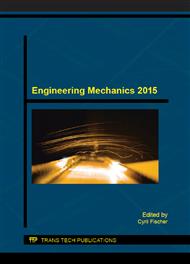p.10
p.16
p.23
p.31
p.39
p.48
p.57
p.63
p.70
Void Fraction Based Two Phase Flow Model of Supersaturated Moist Air
Abstract:
The article deals with the developed of the model of supersaturated moist air flow with condensation. The proposed model is suitable especially for the cases where the rate of change of state variables in the flow field is slow like the flow in natural draft wet-cooling towers and in general the low Mach number flow. Void fraction of gas phase is included in governing equations. Homogeneous equilibrium model, where the two phases are well mixed and have the same velocity, is used. The results of the numerical solutions of the convergent nozzle are presented. The numerical fluxes are based on AUSM + -up scheme and temporal discretization is based on four stage order three explicit strong stability preserving Runge-Kutta method with non-negative coefficients.
Info:
Periodical:
Pages:
39-47
Citation:
Online since:
January 2016
Authors:
Price:
Сopyright:
© 2016 Trans Tech Publications Ltd. All Rights Reserved
Share:
Citation:


